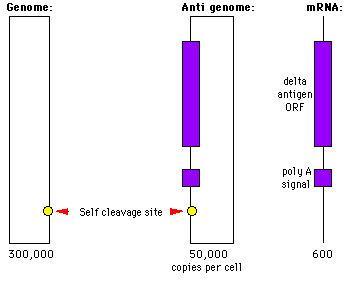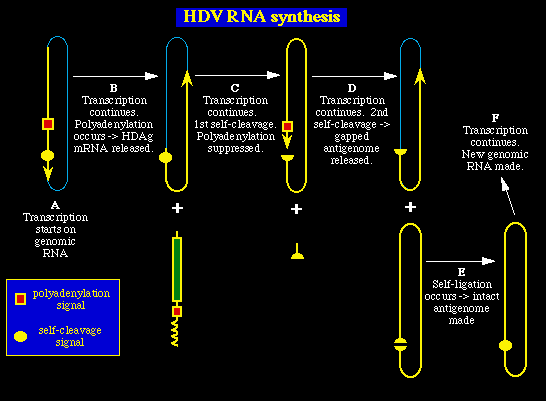Replication
HDV's unique replication distinguishes it from other animal viruses. Although, HDV infection depends on the presence of Hepatitis B Virus (HBV), HDV replication does not require the presence of HBV. HBV is needed for the production of HDV virions. After entering the cell nucleus and uncoating, the HDV genome uses the cell’s RNA polymerase II to transcribe two types of RNA: (1) circular, plus sense RNA, called the antigenome; and (2) shorter, polyadenylated, linear RNA. The circular RNA is used as a template for new genomic RNA. The linear RNA is transported to the cytoplasm where it undergoes translation to new HDAg.
Figure 1: Three RNAs of HDV

source: http://www.tulane.edu/~dmsander/WWW/335/HDV.html
HDV is unusual because it is the only human negative-stranded RNA virus that links together the transcription of both the antigenome and the mRNA. Using a mechanism known in many plant viruses as the double rolling circle model, the genome transcribes both RNAs with a single initiation. In Step A {Figure 2}, transcription starts and continues through the polyadenylated and self-cleavage sites. Polyadenylation processes the RNA and releases the HDAg mRNA that travels to the cytoplasm (Step B). The antigenomic RNA strand undergoes self-cleavage and continues transcribing for another 1.7kb(the length of the genomic RNA). Self-cleavage somehow prevents normal downstream fragment degradation. Usually after mRNA processing, the unused RNA is degraded. Not in this case! During this continued transcription, polyadenylation is suppressed (Step C). After transcribing 1.7kb, the second self-cleavage occurs. This releases the unit-length antigenome RNA (StepD). The antigenome (+) undergoes self-ligation to form the circular template for the genomic RNA (-) (Step E). The virus uses RNA polymerase II again to transcribe copies of the genome.
Assembly of the HDV virion requires the envelope proteins (HBsAg) of the helper hepadnavirus, HBV. Without the envelope the virus cannot replicate properly. This is why coinfection or superinfection with HBV is necessary.
Figure 2

Source: Perrotta, Anne T.; Been, Michael D. "A pseudoknot-like
structure required for
efficient
self-cleavage of hepatitis delta virus RNA." Nature v350, n6317
(April 4, 1991):434.